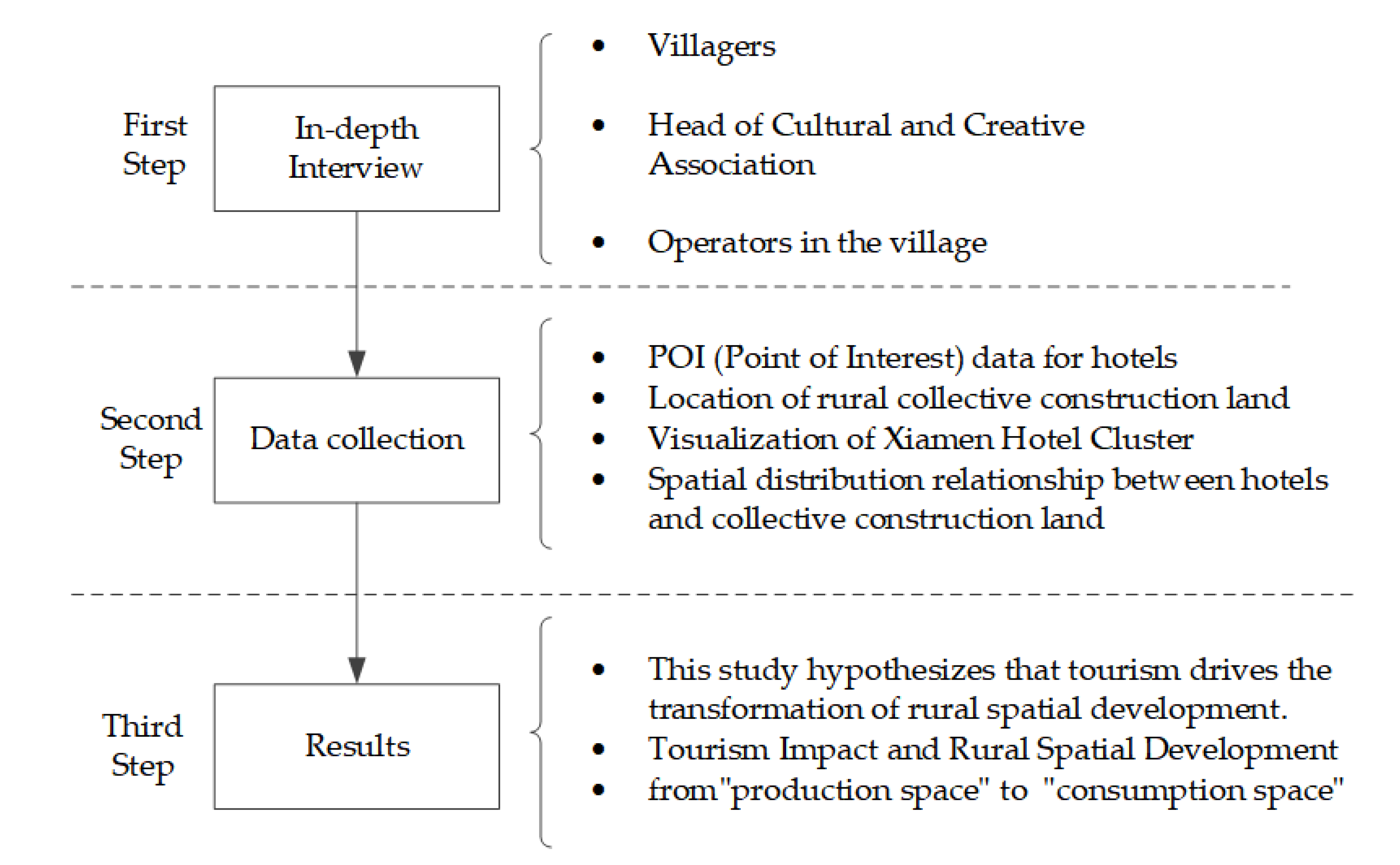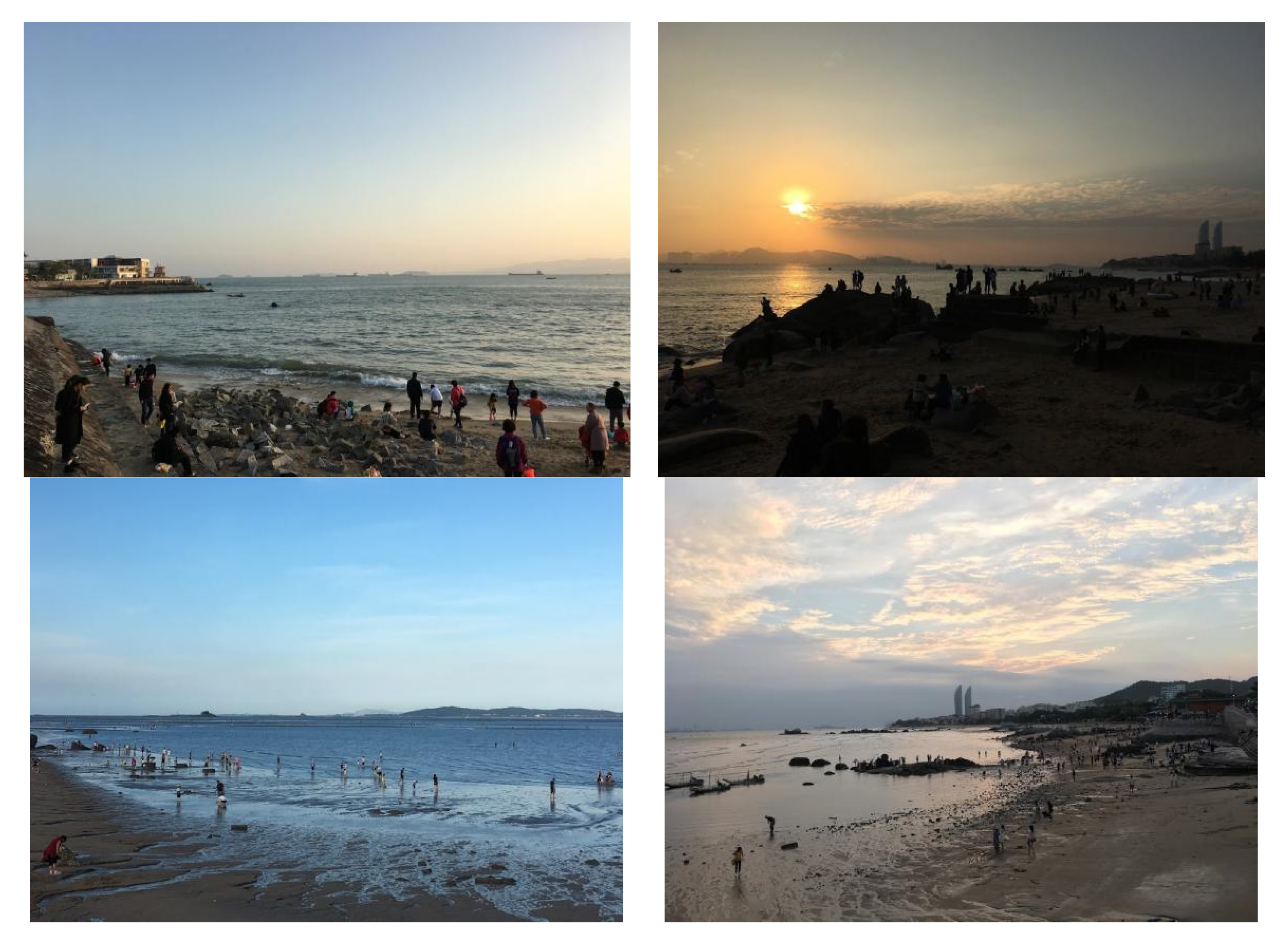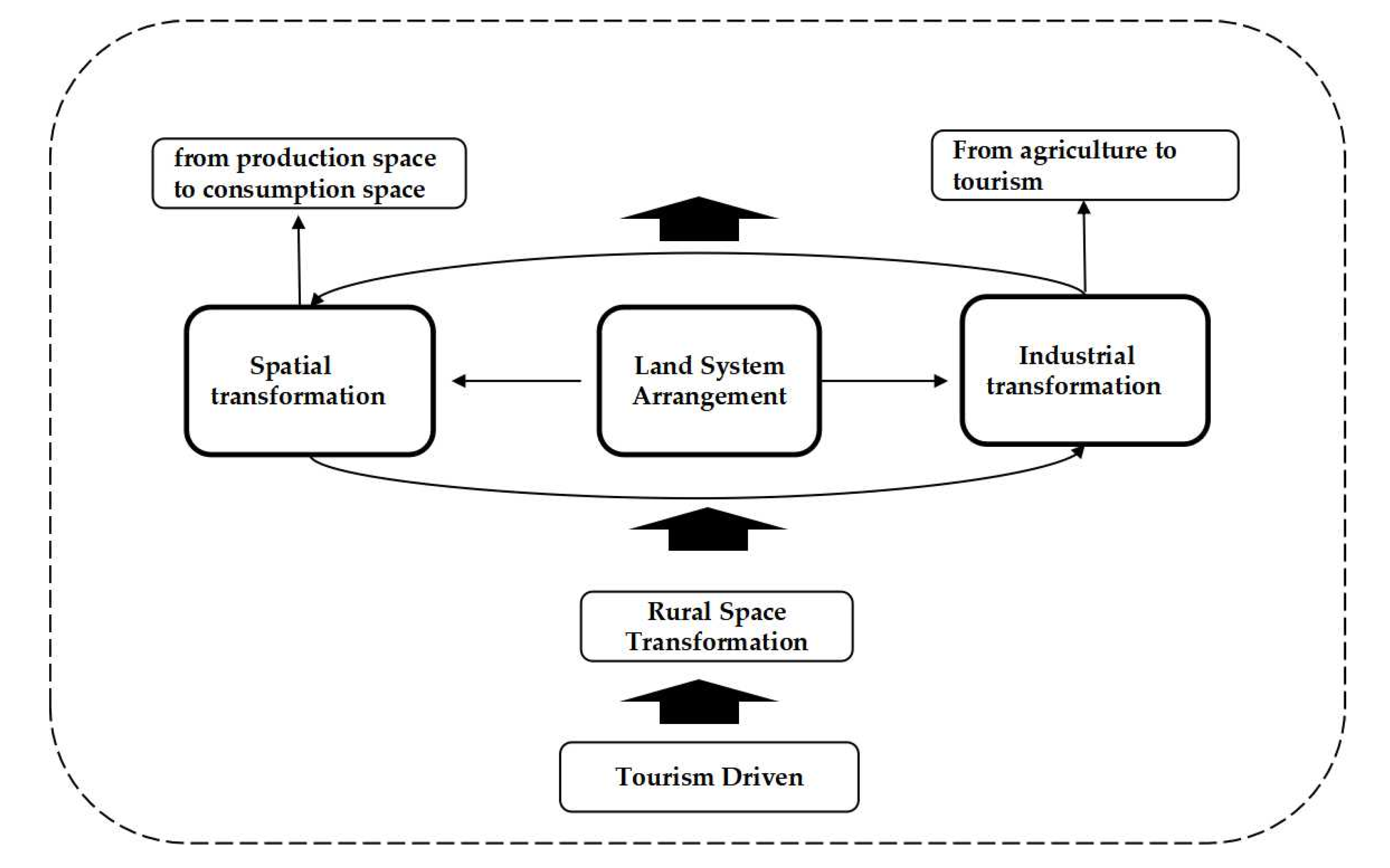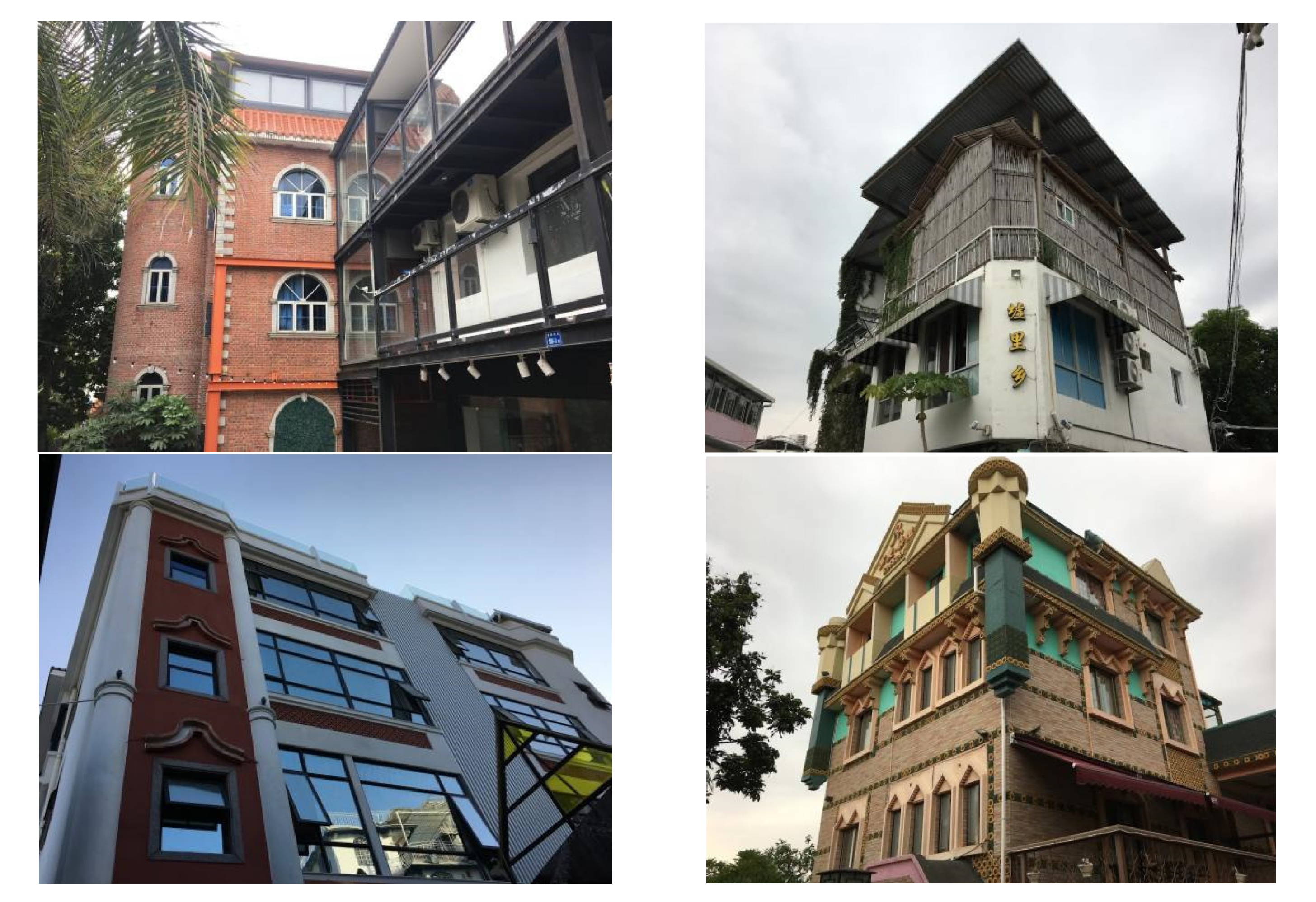Transformation of Rural Space under the Impact of Tourism: The Case of Xiamen, China
Abstract
1. Introduction
2. Literature Review
2.1. Tourism and Sustainable Rural Development
2.2. Rural Tourism and Rural Revitalization
3. Research Methods
3.1. Study Area
3.2. Research Methodology
4. Rural Spatial Development Transformation under the Impact of Tourism
4.1. Tourism-Driven Changes in Rural Development
4.2. Tourism-Driven and Rural Spatial Development Transformation
5. Discussion and Conclusions
Author Contributions
Funding
Conflicts of Interest
References
- Mullins, P. Tourism urbanization. Int. J. Urban Reg. Res. 1991, 15, 326–342. [Google Scholar] [CrossRef]
- Gladstone, D.L. Tourism urbanization in the United States. Urban Aff. Rev. 1998, 34, 3–27. [Google Scholar] [CrossRef]
- Mullins, P. Cities for pleasure: The emergence of tourism urbanization in Australia. Built Environ. 1978, 1992, 187–198. [Google Scholar]
- Neuts, B. Tourism and urban economic growth: A panel analysis of German cities. Tour. Econ. 2020, 26, 519–527. [Google Scholar] [CrossRef]
- Lim, C.; Zhu, L.; Koo, T.T.R. Urban redevelopment and tourism growth: Relationship between tourism infrastructure and international visitor flows. Int. J. Tour. Res. 2019, 21, 187–196. [Google Scholar] [CrossRef]
- Blázquez-Salom, M.; Blanco-Romero, A.; Vera-Rebollo, F.; Ivars-Baidal, J. Territorial tourism planning in Spain: From boosterism to tourism degrowth? J. Sustain. Tour. 2019, 27, 1764–1785. [Google Scholar] [CrossRef]
- Getz, D. Tourism and population change: Long-term impacts of tourism in the Badenoch and Strathspey district of the Scottish highlands. Scott. Geogr. Mag. 1986, 102, 113–126. [Google Scholar] [CrossRef]
- Kongbuamai, N.; Zafar, M.W.; Zaidi, S.A.H.; Lui, Y. Determinants of the ecological footprint in Thailand: The influences of tourism, trade openness, and population density. Environ. Sci. Pollut. Res. 2020, 27, 40171–40186. [Google Scholar] [CrossRef]
- Möller, P.; Amcoff, J. Tourisms localised population effect in the rural areas of Sweden. Scand. J. Hosp. Tour. 2018, 18, 39–55. [Google Scholar] [CrossRef]
- Mehraliyev, F.; Choi, Y.; Koseoglu, M.A. Social structure of social media research in tourism and hospitality. Tour. Recreat. Res. 2019, 44, 451–465. [Google Scholar] [CrossRef]
- Krippendorf, J. Towards new tourism policies: The importance of environmental and sociocultural factors. Tour. Manag. 1982, 3, 135–148. [Google Scholar] [CrossRef]
- Rasul, T.; Hoque, M.R. A review of social media research in the tourism and hospitality Industry through the lens of social structure. Tour. Recreat. Res. 2020, 45, 425–427. [Google Scholar] [CrossRef]
- Heslinga, J.H.; Groote, P.; Vanclay, F. Using a social-ecological systems perspective to understand tourism and landscape interactions in coastal areas. J. Tour. Futures 2017, 3, 23–38. [Google Scholar] [CrossRef]
- Marafa, L. Tourism imaginary and landscape at heritage site: A case in Honghe Hani Rice terraces, China. Land 2021, 10, 439. [Google Scholar]
- Miller, D.M.S. Disaster tourism and disaster landscape attractions after hurricane Katrina: An auto-ethnographic journey. Int. J. Cult. Tour. Hosp. Res. 2008, 2, 115–131. [Google Scholar] [CrossRef]
- Ruda, A. Contribution to assessement of the tourism impact on landscape. Auc Geogr. 2019, 45, 61–74. [Google Scholar] [CrossRef]
- Daugstad, K. Negotiating landscape in rural tourism. Ann. Tour. Res. 2008, 35, 402–426. [Google Scholar] [CrossRef]
- Sharma, B.; Dyer, P. An investigation of differences in residents’ perceptions on the Sunshine coast: Tourism impacts and demographic variables. Tour. Geogr. 2009, 11, 187–213. [Google Scholar] [CrossRef]
- Sinclair-Maragh, G. Demographic analysis of residents’ support for tourism development in Jamaica. J. Destin. Mark. Manag. 2017, 6, 5–12. [Google Scholar] [CrossRef]
- Yang, L.; Liang, Y.; He, B.; Lu, Y.; Gou, Z. COVID-19 effects on property markets: The pandemic decreases the implicit price of metro accessibility. Tunn. Undergr. Space Technol. 2022, 125, 104528. [Google Scholar] [CrossRef]
- He, B.J.; Wang, J.; Zhu, J.; Qi, J. Beating the urban heat: Situation, background, impacts and the way forward in China. Renew. Sustain. Energy Rev. 2022, 161, 112350. [Google Scholar] [CrossRef]
- He, B.J.; Zhao, D.X.; Zhu, J.; Darko, A.; Gou, Z.H. Promoting and implementing urban sustainability in China: An integration of sustainable initiatives at different urban scales. Habitat Int. 2018, 82, 83–93. [Google Scholar] [CrossRef]
- Gao, X.; Zhu, J.; He, B.J. The linkage between sustainable development goals 9 and 11: Examining the association between sustainable urbanization and intellectual property rights protection. Adv. Sustain. Syst. 2022, 6, 2100283. [Google Scholar] [CrossRef]
- Qian, J.; Feng, D.; Zhu, H. Tourism-driven urbanization in China’s small town development: A case study of Zhapo town, 1986–2003. Habitat Int. 2012, 36, 152–160. [Google Scholar] [CrossRef]
- Luo, J.M.; Qiu, H.; Goh, C.; Wang, D. An analysis of tourism development in China from urbanization perspective. J. Qual. Assur. Hosp. Tour. 2016, 17, 24–44. [Google Scholar] [CrossRef]
- Chen, M.; Zhou, Y.; Huang, X.; Ye, C. The integration of new-type urbanization and rural revitalization strategies in China: Origin, reality and future trends. Land 2021, 10, 207. [Google Scholar] [CrossRef]
- Liu, Y. Introduction to land use and rural sustainability in China. Land Use Policy 2018, 74, 1–4. [Google Scholar] [CrossRef]
- Yang, J.; Yang, L.; Ma, H. Community participation strategy for sustainable urban regeneration in Xiamen, China. Land 2022, 11, 600. [Google Scholar] [CrossRef]
- Zhou, Y.; Li, Y.; Xu, C. Land consolidation and rural revitalization in China: Mechanisms and paths. Land Use Policy 2020, 91, 104379. [Google Scholar] [CrossRef]
- Li, L.; Yang, Q.; Xie, X. Coupling coordinated evolution and forecast of tourism-urbanization-ecological environment: The case study of Chongqing, China. Math. Probl. Eng. 2021, 2021, 7271637. [Google Scholar] [CrossRef]
- Liu, S.; Geng, Y.; Zhang, J.; Kang, X.; Shi, X.; Zhang, J. Ecological trap in tourism-urbanization: Simulating the stagnation and restoration of urbanization from the perspective of government incentives. Ecol. Econ. 2021, 185, 107054. [Google Scholar] [CrossRef]
- Su, M.M.; Sun, Y.; Wall, G.; Min, Q. Agricultural heritage conservation, tourism and community livelihood in the process of urbanization–Xuanhua Grape Garden, Hebei province, China. Asia Pac. J. Tour. Res. 2020, 25, 205–222. [Google Scholar] [CrossRef]
- Rico-Amoros, A.M.; Olcina-Cantos, J.; Saurí, D. Tourist land use patterns and water demand: Evidence from the Western Mediterranean. Land Use Policy 2009, 26, 493–501. [Google Scholar] [CrossRef]
- Jenberu, A.A.; Admasu, T.G. Urbanization and land use pattern in Arba Minch town, Ethiopia: Driving forces and challenges. GeoJournal 2020, 85, 761–778. [Google Scholar] [CrossRef]
- Onur, I.; Maktav, D.; Sari, M.; Kemal Sönmez, N. Change detection of land cover and land use using remote sensing and GIS: A case study in Kemer, Turkey. Int. J. Remote Sens. 2009, 30, 1749–1757. [Google Scholar] [CrossRef]
- Yang, J.; Yang, R.; Chen, M.H.; Su, C.H.J.; Zhi, Y.; Xi, J. Effects of rural revitalization on rural tourism. J. Hosp. Tour. Manag. 2021, 47, 35–45. [Google Scholar] [CrossRef]
- Petrov, L.O.; Lavalle, C.; Kasanko, M. Urban land use scenarios for a tourist region in Europe: Applying the MOLAND model to Algarve, Portugal. Landsc. Urban Plan. 2009, 92, 10–23. [Google Scholar] [CrossRef]
- Hall, C.M. Tourism urbanization and global environmental change. In Tourism and Global Environmental Change: Ecological, Economic, Social and Political Interrelationships; Routledge, Taylor Francis Group: Abingdon, UK, 2006; pp. 142–156. [Google Scholar]
- Zhang, Q.; Lu, L.; Huang, J.; Zhang, X. Uneven development and tourism gentrification in the metropolitan fringe: A case study of Wuzhen Xizha in Zhejiang Province, China. Cities 2022, 121, 103476. [Google Scholar] [CrossRef]
- Yang, J.; Cai, Y.; Ma, H.; Weng, L. Governance Strategies for Informal Settlements in China: The Case of Guangzhou. Buildings 2022, 12, 547. [Google Scholar] [CrossRef]
- Yu, H.; Yang, J.; Sun, D.; Li, T.; Liu, Y. Spatial responses of ecosystem service value during the development of urban agglomerations. Land 2022, 11, 165. [Google Scholar] [CrossRef]
- Yu, H.; Yang, J.; Li, T.; Jin, Y.; Sun, D. Morphological and functional polycentric structure assessment of megacity: An integrated approach with spatial distribution and interaction. Sustain. Cities Soc. 2022, 80, 103800. [Google Scholar] [CrossRef]
- Li, K.X.; Jin, M.; Shi, W. Tourism as an important impetus to promoting economic growth: A critical review. Tour. Manag. Perspect. 2018, 26, 135–142. [Google Scholar] [CrossRef]
- Oh, C.O. The contribution of tourism development to economic growth in the Korean economy. Tour. Manag. 2005, 26, 39–44. [Google Scholar] [CrossRef]
- Croes, R. The role of tourism in poverty reduction: An empirical assessment. Tour. Econ. 2014, 20, 207–226. [Google Scholar] [CrossRef]
- Vanegas, M., Sr.; Gartner, W.; Senauer, B. Tourism and poverty reduction: An economic sector analysis for Costa Rica and Nicaragua. Tour. Econ. 2015, 21, 159–182. [Google Scholar] [CrossRef]
- Liang, Z.; Bao, J. Targeted poverty alleviation in China: Segmenting small tourism entrepreneurs and effectively supporting them. J. Sustain. Tour. 2018, 26, 1984–2001. [Google Scholar] [CrossRef]
- Lopes, H.D.S.; Remoaldo, P.; Ribeiro, V. Residents’ perceptions of tourism activity in a rural North-Eastern Portuguese community: A cluster analysis. Bull. Geography. Socio. Econ. Ser. 2019, 46, 119–135. [Google Scholar] [CrossRef]
- Li, Y.; Zhang, H.; Zhang, D.; Abrahams, R. Mediating urban transition through rural tourism. Ann. Tour. Res. 2019, 75, 152–164. [Google Scholar] [CrossRef]
- Pons, A.; Rullán, O.; Murray, I. Tourism capitalism and island urbanization: Tourist accommodation diffusion in the Balearics, 1936–2010. Isl. Stud. J. 2014, 9, 239–258. [Google Scholar] [CrossRef]
- Brahmasrene, T.; Lee, J.W. Assessing the dynamic impact of tourism, industrialization, urbanization, and globalization on growth and environment in Southeast Asia. Int. J. Sustain. Dev. World Ecol. 2017, 24, 362–371. [Google Scholar] [CrossRef]
- Novy, J. Urban tourism as a bone of contention: Four explanatory hypotheses and a caveat. Int. J. Tour. Cities 2018, 5, 63–74. [Google Scholar] [CrossRef]
- Manzoor, F.; Wei, L.; Asif, M.; Haq, M.Z.; Rehman, H.U. The contribution of sustainable tourism to economic growth and employment in Pakistan. Int. J. Environ. Res. Public Health 2019, 16, 3785. [Google Scholar] [CrossRef] [PubMed]
- Petrova, M.; Dekhtyar, N.; Klok, O.; Loseva, O. Regional tourism infrastructure development in the state strategies. Probl. Perspect. Manag. 2018, 16, 259–274. [Google Scholar] [CrossRef]
- Lundmark, L.; Fredman, P.; Sandell, K. National Parks and Protected Areas and the Role for Employment in Tourism and Forest Sectors: A Swedish Case. Ecol. Soc. 2010, 15, 299–305. [Google Scholar] [CrossRef]
- Pearce, P.L.; Wu, M.Y. Soft infrastructure at tourism sites: Identifying key issues for Asian tourism from case studies. Tour. Recreat. Res. 2015, 40, 120–132. [Google Scholar] [CrossRef]
- Harrison, D. Pro-poor tourism: A critique. Third World Q. 2008, 29, 851–868. [Google Scholar] [CrossRef]
- Goodwin, H. Reflections on 10 years of pro-poor tourism. J. Policy Res. Tour. Leis. Events 2009, 1, 90–94. [Google Scholar] [CrossRef]
- Gascón, J. Pro-poor tourism as a strategy to fight rural poverty: A critique. J. Agrar. Chang. 2015, 15, 499–518. [Google Scholar] [CrossRef]
- Goodwin, H. Pro-poor tourism: A response. Third World Q. 2008, 29, 869–871. [Google Scholar] [CrossRef]
- Sofield, T.; Bauer, J.; De Lacy, T.; Lipman, G.; Daughterty, S. Sustainable Tourism~Eliminating Poverty (ST~EP); CRC for Sustainable Tourism Pty Ltd.: Gold Coast, Australia, 2004; Volume 76. [Google Scholar]
- Kala, N.; Abaydeldinov, Y.; Furman, T.; Ponomarev, A. The world tourism organization for countering terrorist threats. J. East Asia Int. Law 2017, 10, 549. [Google Scholar] [CrossRef][Green Version]
- Zeng, B. How can social enterprises contribute to sustainable pro-poor tourism development? Chin. J. Popul. Resour. Environ. 2018, 16, 159–170. [Google Scholar] [CrossRef]
- Liu, C.; Dou, X.; Li, J.; Cai, L.A. Analyzing government role in rural tourism development: An empirical investigation from China. J. Rural. Stud. 2020, 79, 177–188. [Google Scholar] [CrossRef]
- Dinis, I.; Simões, O.; Cruz, C.; Teodoro, A. Understanding the impact of intentions in the adoption of local development practices by rural tourism hosts in Portugal. J. Rural. Stud. 2019, 72, 92–103. [Google Scholar] [CrossRef]
- Su, M.M.; Wall, G.; Wang, Y.; Jin, M. Livelihood sustainability in a rural tourism destination-Hetu Town, Anhui Province, China. Tour. Manag. 2019, 71, 272–281. [Google Scholar] [CrossRef]
- Chi, X.; Han, H. Emerging rural tourism in China’s current tourism industry and tourist behaviors: The case of Anji County. J. Travel Tour. Mark. 2021, 38, 58–74. [Google Scholar] [CrossRef]
- Gao, J.; Wu, B. Revitalizing traditional villages through rural tourism: A case study of Yuanjia Village, Shaanxi Province, China. Tour. Manag. 2017, 63, 223–233. [Google Scholar] [CrossRef]
- Li, T.; Liu, J.; Zhu, H.; Zhang, S. Business characteristics and efficiency of rural tourism enterprises: An empirical study from China. Asia Pac. J. Tour. Res. 2018, 23, 549–559. [Google Scholar] [CrossRef]
- Kan, K. Creating land markets for rural revitalization: Land transfer, property rights and gentrification in China. J. Rural. Stud. 2021, 81, 68–77. [Google Scholar] [CrossRef]
- Yang, J.; He, Z.; Ma, H. Comparison of collective-led and state-led land development in china from the perspective of institutional arrangements: The case of Guangzhou. Land 2022, 11, 226. [Google Scholar] [CrossRef]
- Sun, P.; Zhou, L.; Ge, D.; Lu, X.; Sun, D.; Lu, M.; Qiao, W. How does spatial governance drive rural development in China’s farming areas? Habitat Int. 2021, 109, 102320. [Google Scholar] [CrossRef]
- Williamson, O.E. The new institutional economics: Taking stock, looking ahead. J. Econ. Lit. 2000, 38, 595–613. [Google Scholar] [CrossRef]
- North, D.C. Institutions. J. Econ. Perspect. 1991, 5, 97–112. [Google Scholar] [CrossRef]
- North, D.C.; Thomas, R.P. The Rise of the Western World: A New Economic History; Cambridge University Press: Cambridge, UK, 1973. [Google Scholar]







Publisher’s Note: MDPI stays neutral with regard to jurisdictional claims in published maps and institutional affiliations. |
© 2022 by the authors. Licensee MDPI, Basel, Switzerland. This article is an open access article distributed under the terms and conditions of the Creative Commons Attribution (CC BY) license (https://creativecommons.org/licenses/by/4.0/).
Share and Cite
Yang, J.; Ma, H.; Weng, L. Transformation of Rural Space under the Impact of Tourism: The Case of Xiamen, China. Land 2022, 11, 928. https://doi.org/10.3390/land11060928
Yang J, Ma H, Weng L. Transformation of Rural Space under the Impact of Tourism: The Case of Xiamen, China. Land. 2022; 11(6):928. https://doi.org/10.3390/land11060928
Chicago/Turabian StyleYang, Jinkun, Haitao Ma, and Lisheng Weng. 2022. "Transformation of Rural Space under the Impact of Tourism: The Case of Xiamen, China" Land 11, no. 6: 928. https://doi.org/10.3390/land11060928
APA StyleYang, J., Ma, H., & Weng, L. (2022). Transformation of Rural Space under the Impact of Tourism: The Case of Xiamen, China. Land, 11(6), 928. https://doi.org/10.3390/land11060928






